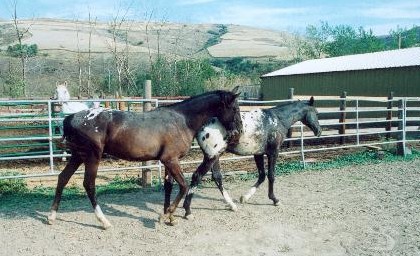| |
Rudy Shebala, Director of the Nez Perce Young Horsemen Program and Registry, discusses the horse program along the Lolo Trail (Interviewed by Sally Thompson and Kenneth Furrow in July 2001) |
From its initial arrival on the camas prairie in the 1730s, and into today, the horse has been an integral member of the Nimíipuu family. In 1998 the Nez Perce Tribal Executive Committee established the "Nez Perce Horse Registry."

|
The Nez Perce Horse - Nimíipuu Sik'em
|
Crossing the dramatically spotted and sturdy Appaloosa with the swift, hot-blooded Akhal-Teke, the Nez Perce Horse Registry is creating a new breed: the Nez Perce Horse, Nimíipuu Sik'em. The Akhal-Teke is an ancient Asian breed from Turkmenistan, known for its endurance and stamina, and is very similar to the original Spanish horse brought to North America. The horse has a long sleek body, narrow chest and long neck and legs, and is well adapted to the distance travel of its former desert homeland. The Nimíipuu horse reported by Lewis and Clark was a colorful spotted horse that roamed the Palouse countryside in what would become north-central Idaho. Referred to by white settlers as the "Palouse horse," over time the words were slurred, resulting in the term, "Appaloosa," and formally recognized as a breed in 1938. And over that same time period the Nimíipuu horse was crossbreed with Thoroughbred and Quarter Horse lines, modifying the horse of 1805, to create an outstanding breed onto itself. With the success of the Nez Perce Horse Registry, the Nimíipuu horse of the 21st Century is thus once again akin to its ancestor of the 18th Century.
| |
Rudy Shebala, Nez Perce Horse Registry, discusses the creation of the Nez Perce Horse, the Nimíipuu Sik'em. (Interviewed by Josiah Pinkham February 2002) |
Together with the Nez Perce Young Horsemen Program, established in 1994, the Nimíipuu have an active academic, equestrian and employment program for the youth of the tribe to complement their breeding enterprise. Throughout the year, tribal youth are taken on horse trail trips and parade at ceremonial events throughout the country.
| |
Angel Sobotta discusses her horse parading outfit (Interviewed by Ann McCormack February 2002) |
For additional information on the horse and the Nimíipuu, ride on over to the Horse in Nimíipuu Culture.
© Nez Perce Tribe 2002
< previous |










